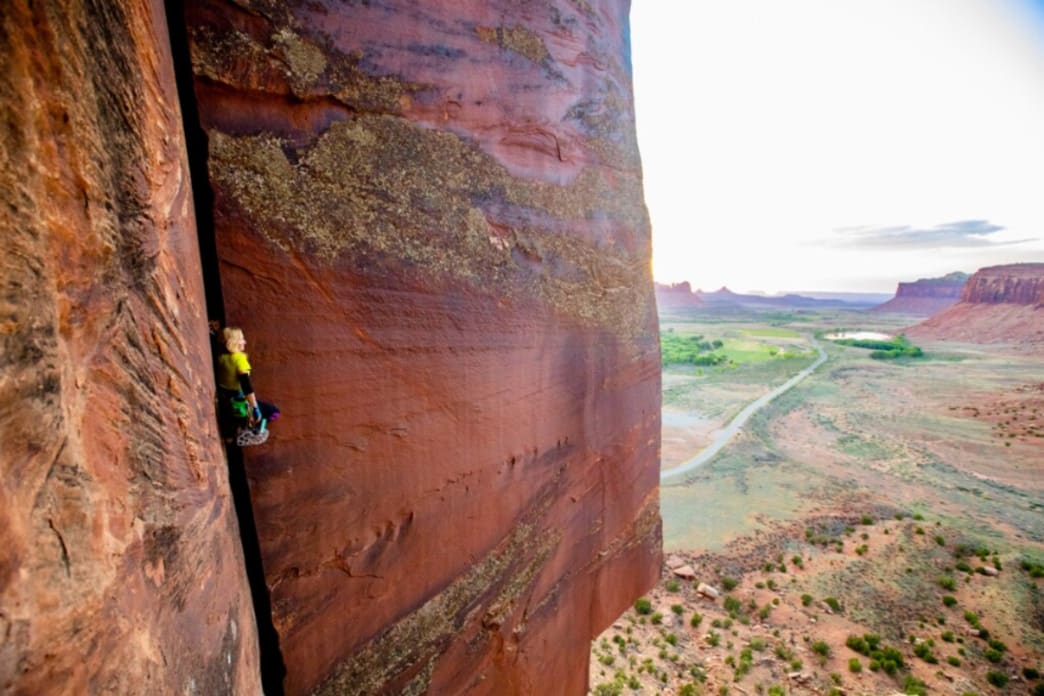Q&A with Pro Climber, Pamela Pack

Pamela is a skilled rock climber and surveyor with a Yale University degree and a Professional Certification in Geographic Information Systems and Remote Sensing. Pamela has been on a quest to climb North America's most difficult inverted and vertical offwidth routes since 2008. In 2009, she was awarded the coveted Golden Piton Award for traditional climbing for her outstanding achievements in Zion National Park, for the first ascent of Gabriel 5.13c, a 65′ inverted offwidth roof. Pamela has made over 50 first female offwidth ascents in the American West, including the first female ascent of Lucille 5.13a (onsight) in Vedauwoo, Wyoming.
If climbing remains a male-dominated activity, offwidth crack climbing is the pinnacle of that inequality. Pamela Pack learned offwidth climbing the hard way when a devastating forearm injury rendered her unable to crimp, but her hand stacking abilities and ability to endure enormous levels of pressure were unaffected by this injury.
Q&A with Pro Climber, Pamela Pack
We have admired Pamela's passion for climbing and her artistic climbing style. When most people see a photo or video of Pamela climbing they are in awe of the beauty surrounding her as she moves up these zipper like criss crossing gaps etched into the mountain side millions of years ago. As you admire it closer you can appreciate the amount of thought, skill and focus she is putting into each move as she climbs up.
Q: How did you start rock climbing?
Pamela Pack: Well I started climbing when I was 15, my parents sent me to an Outward bound course. I went on an alpine mountaineering course and thats really when I started climbing. I had a bad injury when I was a kid and couldn't do much for a couple of years. Got back into climbing in college and the last 10 years have been a full time climber.
Q: Did you start climbing in a specific style?
Pamela Pack: Yea, I actually started climbing a totally different style. I was indoor climbing, sport climbing, outdoor sports climbing, boulders and big walls. My biggest obsession was ice climbing but one winter I had a really bad injury. My forearms developed chronic exhaustion compartment syndrome, which means there is so much pressure in the muscle compartments that it causes nerve damage. A number of surgeons told me to stop climbing so I began looking through my books and came across offwidth. I came out to Vedauwoo, Wyoming where I am now and climbed upside down and been doing it ever since. Offwidth means it's bigger than your fist and it's where you start stacking body parts while you climb. So like hand stacks, hand fist stacks, double fist stacks and climbing upside down. I figured I could do this because it doesn't involve crimping.
Q: You received a Golden Piton award in 2009, was that for Gabriel?
Pamela Pack: That was for the route Gabriel, and that was really funny because that was before I was a professional climber. I heard there was a route in Zion that no one could do and they have been working on it for 10 years. I did the first ascent of it and at the time I really didn't know what I had done. I was like wow it was really hard a 70 ft inverted style offwidth route. I came home for Christmas and I got a call saying you won the Golden Piton award and I didn't even know what that was. I realized what it was which was for established the most significant new traditional style climb that year. That was the turning point and when I became a professional sponsored climber. It was amazing on one hand but a lot of pressure on the other. It was a plus because the style I do, offwidth wasn't popular and very few women climbed offwidth.
Q: When you are looking at a potential route for the first time how do you plan it?
Pamela Pack: I drive around with my spotting scope and I look at walls and hike for hours and hours. I have a modified lifted truck so I can go anywhere I want to and I look up for lines. I look for lines that are aesthetically spectacular, I like lines with zigzags. Then I will hike out to the base of the lines, look up and study to see if they are possible. I want a new route that captivates me, once that happens I become obsessed. The zigzags are more challenging physically and I like routes that require something new.
Q: Do the routes change realtime while climbing?
Pamela Pack: It's interesting because I will look up and what I think looks like how I'm gonna do it may change when I'm part way up a route. That might occur 100, 200 or 300 ft and realize there is something I can't get around or something I'm climbing is detached some how. I'll have a plan that I'm gonna climb this 400 ft and walk away but it never works out that way. Often what I think looks like a certain size will be dramatically different size when I get to it. But I love it, love the adventure, love being where people have never been.
Follow Pamela at https://www.instagram.com/shanti.pack/
Also big shout out to: @Devinfin, @Brazilianclimbergirl, Friction Labs, La Sportiva, Maxim Ropes and Trango Extraordinary Climbing



